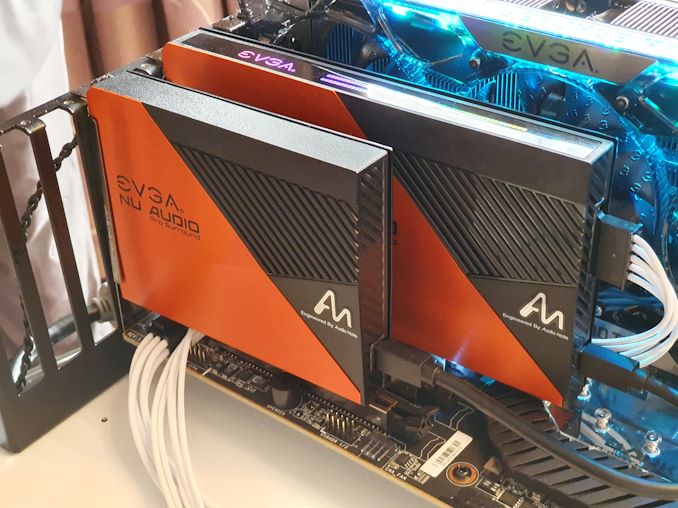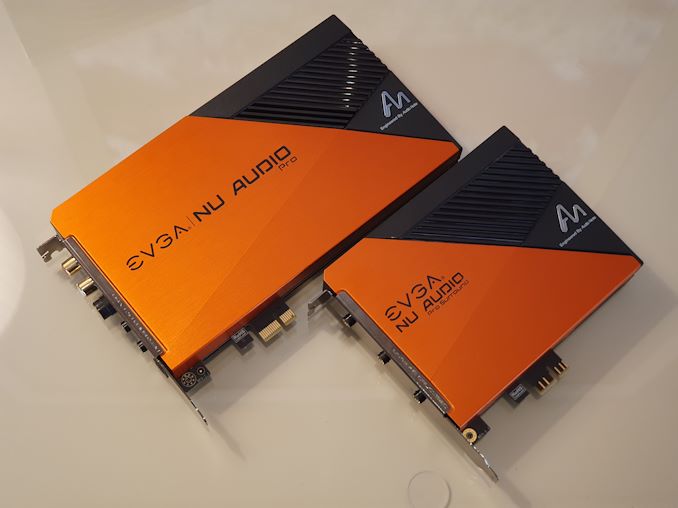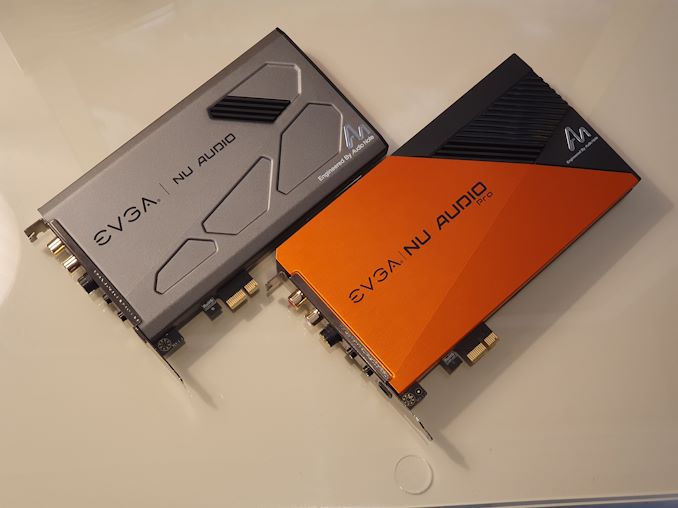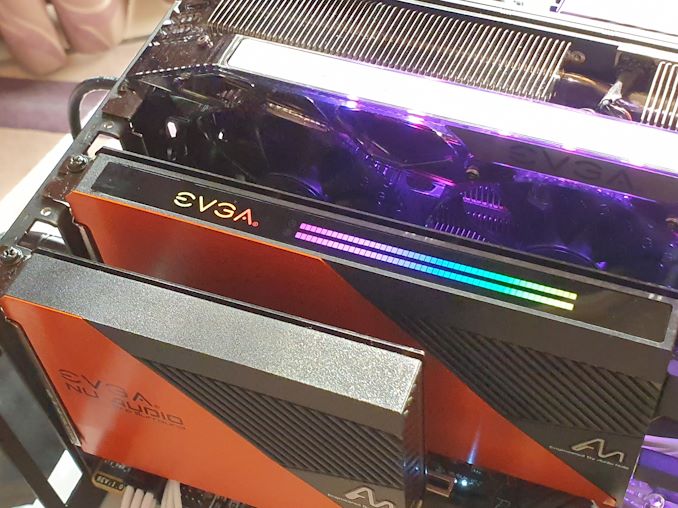CES 2020: EVGA Showcases New Nu Audio Pro Card
by Andrei Frumusanu on January 10, 2020 12:00 PM EST
Initially announced last November, EVGA at CES 2020 showcased the new second generation Nu Audio Pro audio card. The latest model improves upon its predecessor in several ways, including adding 7.1 channel output option, as well as adding RGB lighting. Overall, EVGA remains a relative newcomer to the sound card market, with the company having started off its journey with the original Nu Audio last year, targeting the more niche high-end internal audio solution market.
The new Nu Audio Pro improves upon the first generation in terms of component choices; it still contains the same XMOS xCORE-200 DSP accompanied by Asahi Kasei Microdevices’ (AKM) AK4493 DAC, the AKM AK5572 ADC, and the Cirrus Logic CS5346 ADC. But it’s said that the supporting analog components have been improved so the new characteristics of the card are enhanced.
Design-wise, we’re also seeing a refresh as the new card now sports a red-black finish, and it has hopped on the RGB train with side-mounted LED strips that can be animated and synced with audio playback.
The main board is a straightforward replacement to last year’s model and comes at a $199 price tag.

Nu Audio Pro & Nu Audio Pro Surround
Instead, what’s special for EVGA's audio card this year is the introduction of a second daughter board that allows for 7.1 channel audio playback. The second board has three additional outputs and is fully self-contained in terms of the audio signal generation, including its own DACs. The interface between the card is digital via a repurposed DisplayPort connector between the two boards. The daughterboard’s PCIe connector just serves as grounding as well as structural support – in theory you can have this free-floating instead of having it take up a PCIe slot on your motherboard, but there might be degradations due to possible lesser grounding.
The full Nu Audio Pro kit with the 7.1 add-on card can be had for $299; otherwise the boards are sold separately for $199 and $119 respectively, with availability set in the comings months. Overall, EVGA tells us that they’re continuing to iterate on their designs, and that the company is also investigating the development of an external USB version of the card (The PCIe versions actually use a PCIe to USB bridge internally for connectivity) in the future.












39 Comments
View All Comments
Alexvrb - Sunday, January 12, 2020 - link
I mean people can do whatever makes them happy, but for my personal builds I'd rather buy a non-RGB variant if available. Regardless, I'm not going to use it.That aside these cards are up there in price with the new AE-7 and AE-9 so ouch. I know they're aimed at professionals but still a cut-down consumer audiophile version would be nice, give the AE-5 some competition.
Vitor - Friday, January 10, 2020 - link
Forget this shit and invest on a topping dx3 pro. Great dac with a good headphone amp. Also very boot bluetooth with Ldac.p1esk - Friday, January 10, 2020 - link
Soundblaster G6 is much cheaper + same quality + surround sound.Quantumz0d - Friday, January 10, 2020 - link
I wanted to buy Topping DAC D50s and guess what ? OLED burn in issues. And Tons of QC issues with them not only them. But SMSL as well. And the AMPs they have all suffer with high output impedance which will cause Freq Response change to Low Impedance gear.The SQ is analytical on all the Chi Fi. Esp they all use ESS chips which are hard to implement. LG did a fantastic fucking job in that unfortunately no one recognize them as the best.
So I got myself a Modi with AK4490 stunning rich textured sound, loses DSD (no need tbh) and other fancy BT features which I never use. As for AMP Liquidspark was excellent choice that I made.
Im curious on the NU Audio card. The Peak Meter (?) in Blue color would look stunning imho.
Hopefully its good.
29a - Friday, January 10, 2020 - link
The two are nothing alike.evilspoons - Friday, January 10, 2020 - link
The old version of this (without the RGB or secondary card) is $350 CAD where I'm located ($260 USD at the time of writing). I thought it was a bit expensive but seeing this makes it obvious how overpriced the thing is locally.austinsguitar - Friday, January 10, 2020 - link
and it performed poorly against creative's ae5 which is basically the best sound card on the market for the price.prime2515103 - Friday, January 10, 2020 - link
I would have ran right out and bought one of these, but two things killed it:First, the optical output. Why would they put an output that only supports 5.1 audio on a 7.1 card? This makes no sense. In fairness, there are very few cards with a coaxial output, but it makes no sense on those cards either.
Second, no DSD support even though the DAC supports up to DSD512.
Kevin G - Saturday, January 11, 2020 - link
I'm waiting for one of the audio-over-IP technologies to break out of the professional realm and go mainstream. AES67 has the best chance since that has originated from a standard's body followed by the privately controlled but very popular Dante protocol. AVB is still in the game and has been one of those hidden features in Macs for years now but hasn't had the breakout many were expecting. Still my Aquantia AQ107 card can move 1024 channels of audio at 32 bit, 192 kHz PCM quality with bandwidth to spare. Several Intel NICs also support AVB over 1 Gbit and can pass 128 channels at that same quality. Windows just needs drivers for AVB support, the hardware is already out and relatively wide spread.I have a feeling too many companies are afraid that audio matrixing over the network is too complex for consumers and the lack of wireless support is a deal breaker.
sorten - Friday, January 10, 2020 - link
Wow, I haven't bought a dedicated audio board in more than 15 years. Do they offer significant advantages?